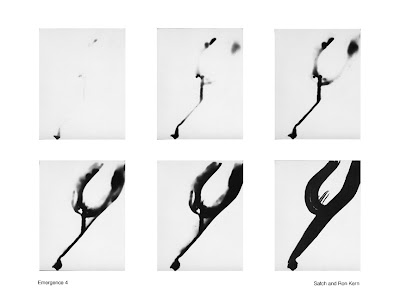Saturday, April 28, 2012
Art Attack 2012 or BUST!
Click on this link to go to a gallery of photos of Satch's journey up to Harbor Country for Art Attack 2012 - great stuff!
Labels:
Art Attack 2012,
Satch
Tuesday, April 24, 2012
Here is our collaboration for the Mad Collab Show hosted by 3040 Indie. For the exhibition the prints were mounted on an oxidized box. Here they are depicted as if they were printed on one piece of paper. Here's a small gallery of snapshots from the show. Click on the graphic to enlarge.
Emergence 4, 2012
Satch and Ron Kern
Archival Inkjet Print of a Photographed Vanished Drawing
This work is a series of prints that depict a woman’s progression of emergence from her most basic essence to the entirety of her being. The final graphic depicts the side view of a woman's torso and her breast.
The collaboration:
The idea for this work came from the desire to combine Satch’s art and Ron’s photography. However, simply photographing something that was created and then assembled was not enough.
Satch decided upon conceiving and executing a painting on a medium where it would be temporary. The painting would be allowed to fade into oblivion only with the assistance of natural forces.
Ron made photographs of this painting as it faded into nothingness. Therefore, the only record of Satch’s work are the photographs, photographs of that which no longer exists.
The concept of emergence was arrived at when Satch and Ron realized that at the heart of what they were getting to was a metaphor for life’s existence. Rather than showing life fading away, as the did the painting fade away, they chose to reverse the order and reveal the beauty of life’s emergence.
Emergence 4, 2012
Satch and Ron Kern
Archival Inkjet Print of a Photographed Vanished Drawing
This work is a series of prints that depict a woman’s progression of emergence from her most basic essence to the entirety of her being. The final graphic depicts the side view of a woman's torso and her breast.
The collaboration:
The idea for this work came from the desire to combine Satch’s art and Ron’s photography. However, simply photographing something that was created and then assembled was not enough.
Satch decided upon conceiving and executing a painting on a medium where it would be temporary. The painting would be allowed to fade into oblivion only with the assistance of natural forces.
Ron made photographs of this painting as it faded into nothingness. Therefore, the only record of Satch’s work are the photographs, photographs of that which no longer exists.
The concept of emergence was arrived at when Satch and Ron realized that at the heart of what they were getting to was a metaphor for life’s existence. Rather than showing life fading away, as the did the painting fade away, they chose to reverse the order and reveal the beauty of life’s emergence.
Labels:
3040 Indie,
Mad Collab Show
Friday, April 20, 2012
Thursday, April 19, 2012
Sunday, April 15, 2012
Monday, April 9, 2012
Marsh Davis, President of Indiana Landmarks Checks In, Again
Today, April 9, 2012 Marsh Davis, President of Indiana Landmarks made this statement about Carmel's historic grain elevator:
"Carmel, as a promoter of arts, is missing an opportunity to use the elevator as a very large art exhibit. It could be interpreted for what it is and how grain elevators affected the course of modern architecture. Not just architecture, but commerce, transportation, agriculture, building materials. It represents major progress and historic changes in all of these forces, and they are embedded in this structure. Interpreting it as such would be innovative and authentic. Assessing the feasibility of that is what Indiana Landmarks was interested in probing and why we offered to study it."
"Carmel, as a promoter of arts, is missing an opportunity to use the elevator as a very large art exhibit. It could be interpreted for what it is and how grain elevators affected the course of modern architecture. Not just architecture, but commerce, transportation, agriculture, building materials. It represents major progress and historic changes in all of these forces, and they are embedded in this structure. Interpreting it as such would be innovative and authentic. Assessing the feasibility of that is what Indiana Landmarks was interested in probing and why we offered to study it."
Labels:
Carmel Grain Elevator
Subscribe to:
Posts (Atom)







